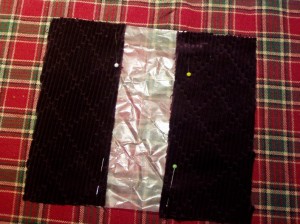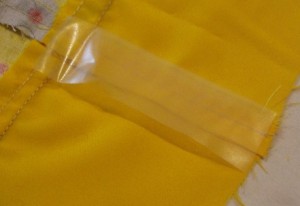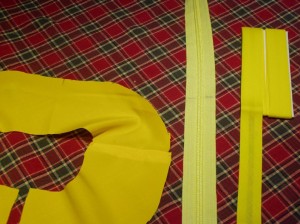 When you are making a zipout lining, the facing with the zipper attachment is where ‘the rubber meets the road’. I’m sure there are other methods of doing this, but this is what works for me. What you will need is what is in the top photo: a finished coat facing (this is a separate back collar facing and front facing, sewn together at the shoulders), a separating zipper as long as you can get it and some wide bias binding. Now, you don’t have to have the zipper or the binding match the facing –you can make the bias binding out anything you’d like – more raincoat fabric, contrasting fabric, the fabric you are using for the raincoat lining itself and so on. Fold the zipper in half and mark both sides of the tape with a pen for your center. Also fold the back neck facing in half and mark that one with a pen for THAT center as well; you’ll want to do this so that you can match up the center points on the zipper and the back neck facing.
When you are making a zipout lining, the facing with the zipper attachment is where ‘the rubber meets the road’. I’m sure there are other methods of doing this, but this is what works for me. What you will need is what is in the top photo: a finished coat facing (this is a separate back collar facing and front facing, sewn together at the shoulders), a separating zipper as long as you can get it and some wide bias binding. Now, you don’t have to have the zipper or the binding match the facing –you can make the bias binding out anything you’d like – more raincoat fabric, contrasting fabric, the fabric you are using for the raincoat lining itself and so on. Fold the zipper in half and mark both sides of the tape with a pen for your center. Also fold the back neck facing in half and mark that one with a pen for THAT center as well; you’ll want to do this so that you can match up the center points on the zipper and the back neck facing.
Step one: Attach the binding to the outside edge of the facing.
What we are doing is attaching something on the outside edge of the facing (which is where the zip out liner is going to attach), which is studier than the raincoat fabric is by itself, in order for the zipper to remain stable. So, what you do is unfold one side of the tape and do it ‘right side to right side’ on the edge and sew it down. Then fold it over, not quite in half – all you are looking for is to cover the raw edge of the facing. You should end up with something that looks like this. 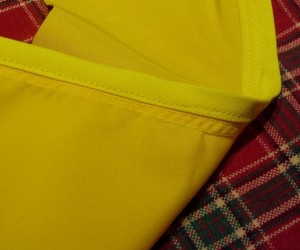
Step two: Match up the center of the binding with the center of one half of the zipper.
Unzip the zipper and lay the binding on one half of the zipper so that it just covers the teeth on the zipper tape. One of the functions of the bias binding is to do this so that you don’t have the teeth exposed when you are wearing the coat without the zip out liner. It should look something like this. 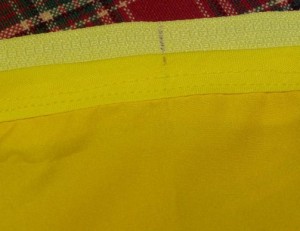
Step three: pin the zipper tape through the binding.
After all the ‘don’t make any more holes in the raincoat fabric than you absolutely have to, I’m breaking my own rules here. This is inside and so the whole waterproof-ness of the outside is not compromised by this and it helps hold the whole thing together because you are going to sew the zipper tape to the binding by hand. Yes, I know there are folks who hate, hate, hate hand sewing. As I said, I’m sure there are people who do this by machine, but I do not.
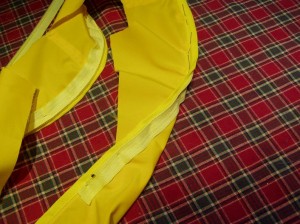 The way I do this is that I go back to the center match up and pin there and then work to the left and right pinning until I get to either end. Sounds crazy, I realize, but with something as long as this, I want to make sure I don’t end up with ‘crawling’.
The way I do this is that I go back to the center match up and pin there and then work to the left and right pinning until I get to either end. Sounds crazy, I realize, but with something as long as this, I want to make sure I don’t end up with ‘crawling’.
Step four: Baste down this half of the zipper.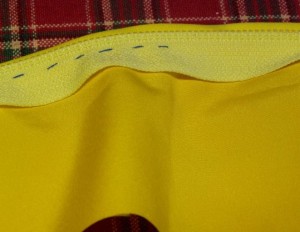 Again, just as with the pins, I start basting in the center back point and baste one half side down to one end and then go back and baste down the other half side all the way down to the end. This will prevent the zipper ‘crawling’ out of synch. Now that I have this firmly attached to the bias tape at the edge, I will pull out the zipper foot on my machine and sew that half of the zipper down.
Again, just as with the pins, I start basting in the center back point and baste one half side down to one end and then go back and baste down the other half side all the way down to the end. This will prevent the zipper ‘crawling’ out of synch. Now that I have this firmly attached to the bias tape at the edge, I will pull out the zipper foot on my machine and sew that half of the zipper down.
In Part Two, I will make the zip-out liner itself and attach the other half of the separating zipper to that and put the facing into the coat.
